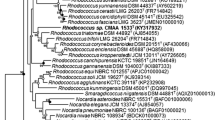Abstract
Rhodococcus opacus 1CP, a potent degrader of (chloro-) aromatic compounds was found to utilise C10–C16 n-alkanes as sole carbon sources. Highest conversion rates were observed with n-tetradecane and n-hexadecane, whereas the utilisation of n-dodecane and n-decane was considerably slower. Thin-layer chromatography of organic extracts of n-alkane-grown 1CP cultures indicated the growth-associated formation of a glycolipid which was characterised as a trehalose dimycolate by 1H-NMR spectroscopy and mass spectrometry. Total chain lengths between 48 and 54 carbons classify the fatty acid residues as nocardiomycolic acids. The presence of two double bonds in each mycolic acid is another feature that distinguishes the corresponding trehalose dinocardiomycolates from trehalose dicorynomycolates reported for Rhodococcus erythropolis DSM43215 and Rhodococcus ruber IEGM231. R. opacus 1CP was not found, even under nitrogen limitation, to produce anionic trehalose tetraesters which have previously been reported for R. erythropolis DSM43215.





Similar content being viewed by others
References
Banat IM, Makkar RS, Cameotra SS (2000) Potential commercial applications of microbial surfactants. Appl Microbiol Biotechnol 53:495–508
Bast E (1999) Mikrobiologische Methoden Spektrum Akad. Verl. Heidelberg, Berlin
Datta AK, Takayama K (1993) Isolation and purification of trehalose 6-mono- and 6,6′-dicorynomycolates from Corynebacterium matruchotii. Structural characterization by 1H NMR. Carbohydr Res 245:151–158
Dorn E, Hellwig M, Reineke W, Knackmuss HJ (1974) Isolation and characterization of a 3-chlorobenzoate degrading pseudomonad. Arch Microbiol 99:61–70
Gorlatov SN, Maltseva OV, Shevchenko VI, Golovleva LA (1989) Degradation of chlorophenols by Rhodococcus erythropolis. Microbiology (English translation of Mikrobiologiya) 58:647–651
Hommel RK, Ratledge C (1993) Biosynthetic mechanisms of low-molecular-weight surfactants and their precursor molecules. In: Kosaric N (ed) Biosurfactants (Surfactant Science Series Vol 48). Marcel Dekker, pp 3–63
Kim JS, Powalla M, Lang S, Wagner F, Lünsdorf H, Wray V (1990) Microbial glycolipid production under nitrogen limitation and resting cell conditions. J Biotechnol 13:257–266
Kitamoto D, Isoda H, Nakahara T (2002) Functions and potential applications of glycolipid biosurfactants—from energy-saving materials to gene delivery carriers. J Biosci Bioeng 94:187–201
Klatte S, Kroppenstedt RM, Rainey FA (1994) Rhodococcus opacus sp. nov., an unusual nutritionally versatile Rhodococcus species. Syst Appl Microbiol 17:355–360
König C, Eulberg D, Gröning J, Lakner S, Seibert V, Kaschabek SR, Schlömann M (2004) A linear megaplasmid, p1CP, carrying the genes for chlorocatechol catabolism of Rhodococcus opacus 1CP. Microbiology 150:3075–3087
Kretschmer A, Wagner F (1983) Characterization of biosynthetic intermediates of trehalose dicorynomycolates from Rhodococcus erythropolis grown on n-alkanes. Biochim Biophys Acta 753:306–313
Kretschmer A, Lang S, Marwede G, Ristau E, Wagner F (1981) Formation of surface active glycolipids by n-alkane utilizing microorganisms. In: Vezina C, Singh K (eds) Advances in Biotechnology. Pergamon, Canada, pp 475–479
Kretschmer A, Bock H, Wagner F (1982) Chemical and physical characterization of interfacial-active lipids from Rhodococcus erythropolis grown on n-alkanes. Appl Environ Microbiol 44:864–870
Lang S (2002) Biological amphiphiles (microbial biosurfactants). Curr Opin Colloid Interface Sci 7:12–20
Moiseeva OV, Lin'ko EV, Baskunov BP, Golovleva LA (1999) Degradation of 2-chlorophenol and 3-chlorobenzoate by Rhodococcus opacus 1CP. Microbiology (English translation of Mikrobiologiya) 68:400–405
Pan YT, Drake RR, Elbein AD (1996) Trehalose-P synthase of mycobacteria: its substrate specificity is affected by polyanions. Glycobiology 6:453–461
Philp JC, Kuyukina MS, Ivshina IB, Dunbar SA, Christofi N, Lang S, Wray V (2002) Alkanotrophic Rhodococcus ruber as a biosurfactant producer. Appl Microbiol Biotechnol 59:318–324
Rapp P, Gabriel-Jürgens LHE (2003) Degradation of alkanes and highly chlorinated benzenes, and production of biosurfactants, by a psychrophilic Rhodococcus sp. and genetic characterization of its chlorobenzene dioxygenase. Microbiology 149:2879–2890
Rapp P, Bock H, Wray V, Wagner F (1979) Formation, isolation, and characterization of trehalose dimycolates from Rhodococcus erythropolis grown on n-alkanes. J Gen Microbiol 115:491–503
Ratledge C (1978) Degradation of aliphatic hydrocarbons. Dev Biodegrad Hydrocarb 1:1–46
Ristau E, Wagner F (1983) Formation of novel anionic trehalose tetraesters from Rhodococcus erythropolis under growth limiting conditions. Biotechnol Lett 5:95–100
Ron EZ, Rosenberg E (2001) Natural roles of biosurfactants. Environ Microbiol 3:229–236
Ryll R, Kumazawa Y, Yano I (2001) Immunological properties of trehalose dimycolate (cord factor) and other mycolic acid-containing glycolipids—a review. Microbiol Immunol 45:801–811
Schippers C, Gessner K, Müller T, Scheper T (2000) Microbial degradation of phenanthrene by addition of a sophorolipid mixture. J Biotechnol 83:189–198
Sikkema J, de Bont JA, Poolman B (1995) Mechanisms of membrane toxicity of hydrocarbons. Microbiol Rev 59:201–222
Singer MEV, Finnerty WR, Tunelid A (1990) Physical and chemical properties of a biosurfactant synthesized by Rhodococcus species H13-A. Can J Microbiol 36:746–750
Sutcliffe IC (1998) Cell envelope composition and organisation in the genus Rhodococcus. Antonie van Leeuwenhoek 74:49–58
Tomiyasu I, Yoshinaga J, Kurano F, Kato Y, Kaneda K, Imaizumi S, Yano I (1986) Occurrence of a novel glycolipid, ‘trehalose 2,3,6′-trimycolate’ in a psychrophilic, acid-fast bacterium, Rhodococcus aurantiacus (Gordona aurantiaca). FEBS Lett 203:239–242
Uchida Y, Tsuchiya R, Chino M, Hirano J, Tabuchi T (1989) Extracellular accumulation of mono- and di-succinoyl trehalose lipids by a strain of Rhodococcus erythropolis grown on n-alkanes. Agric Biol Chem 53:757–763
Ueda S, Fujiwara N, Naka T, Sakaguchi I, Ozeki Y, Yano I, Kasama T, Kobayashi K (2001) Structure–activity relationship of mycoloyl glycolipids derived from Rhodococcus sp. 4306. Microb Pathog 30:91–99
Wick LY, Wattiau P, Harms H (2002) Influence of the growth substrate on the mycolic acid profiles of mycobacteria. Environ Microbiol 4:612–616
Zimmermann K (2003) Biotenside aus Actinobakterien: Herstellung und Charakterisierung anionischer Trehalosetetraester aus verschiedenen Stämmen der Gattung Rhodococcus. Diploma thesis. TU Bergakademie Freiberg
Acknowledgements
We thank Rolf Heckmann for his technical assistance during the glycolipid purification and Manfred Nimtz for MS data. This work was kindly supported by the Deutsche Bundesstiftung Umwelt and by a grant from the European community ICA2-CT-2000-10006.
Author information
Authors and Affiliations
Corresponding author
Rights and permissions
About this article
Cite this article
Niescher, S., Wray, V., Lang, S. et al. Identification and structural characterisation of novel trehalose dinocardiomycolates from n-alkane-grown Rhodococcus opacus 1CP. Appl Microbiol Biotechnol 70, 605–611 (2006). https://doi.org/10.1007/s00253-005-0113-8
Received:
Revised:
Accepted:
Published:
Issue Date:
DOI: https://doi.org/10.1007/s00253-005-0113-8




